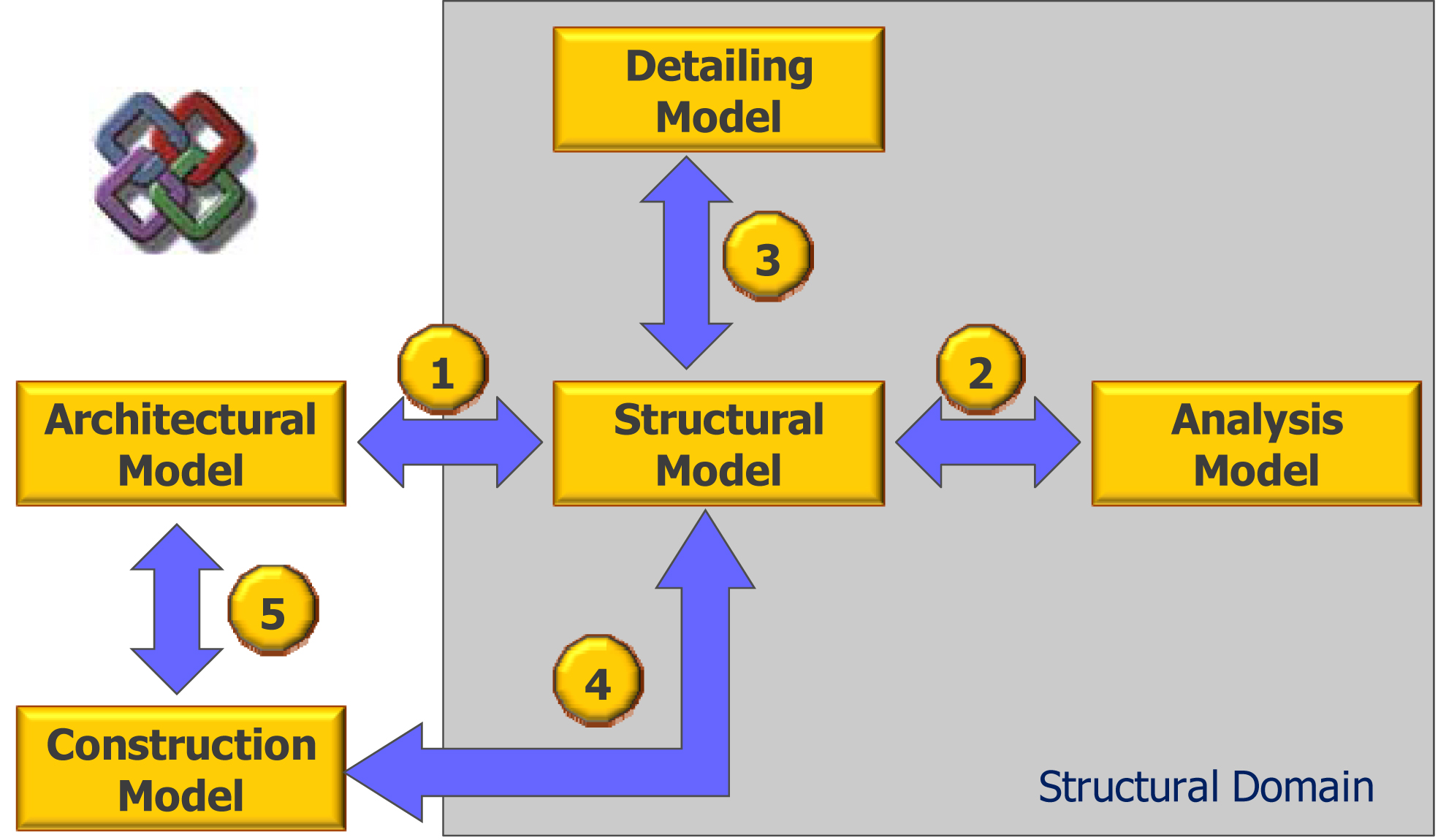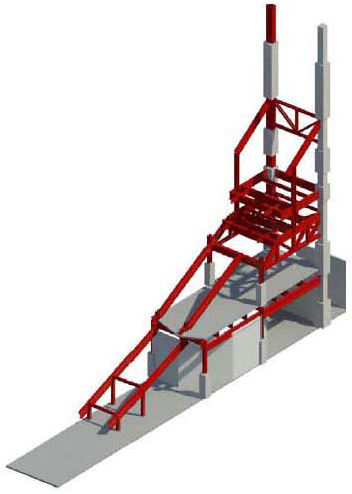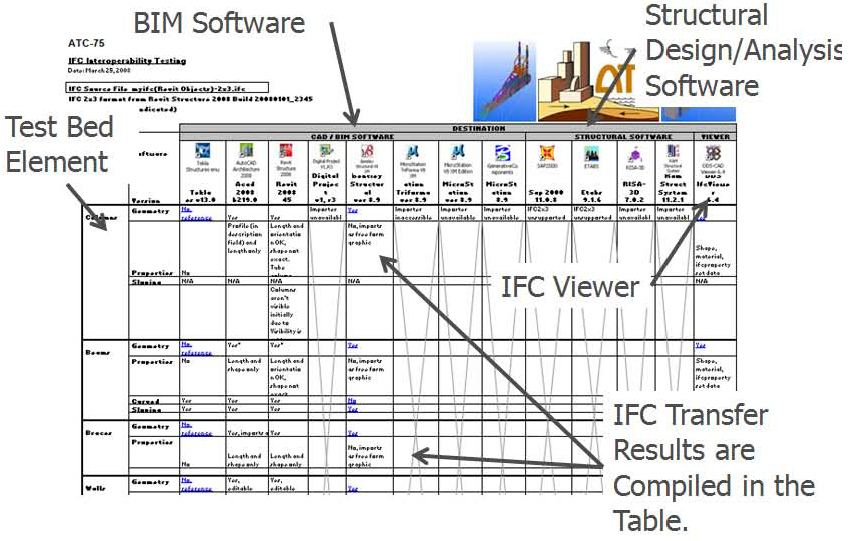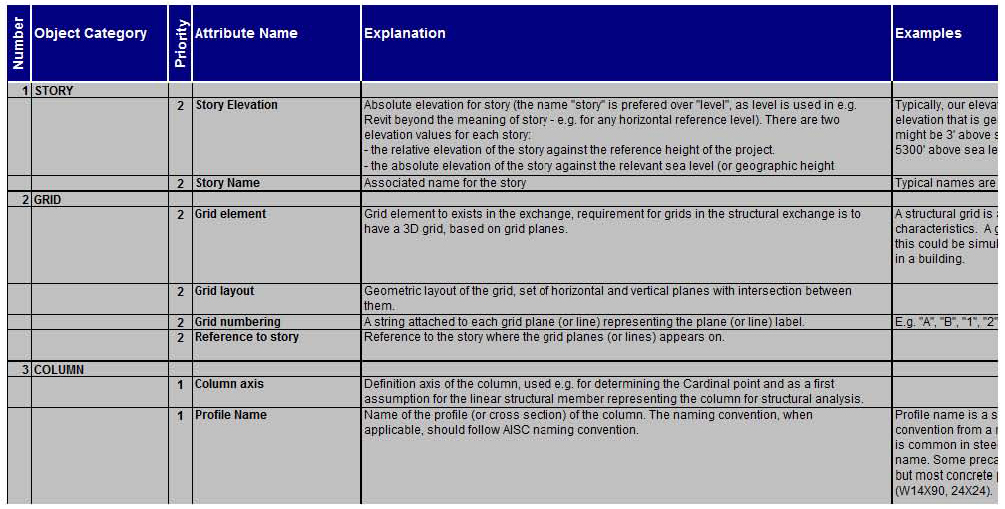ATC-75
Project Description
In September 2007, the Applied Technology Council (ATC) was awarded a grant from the Charles Pankow Foundation to develop an extended set of Industry Foundation Classes (IFCs) for Structural Components for inclusion in the National BIM Standard (NBIMS). This project seeks to improve productivity in the design and construction industry by taking the lead in developing a basis for incorporating and integrating structural design codes, analysis tools and methods into the IFCs of the IAI effort. This project developed the ATC-75 Report, Improvements to BIM Structural Software Interoperability.
What is an IFC?
Industry Foundation Classes (IFCs) are the means to exchange chunks of data related to buildings that software vendors have agreed to use when their software systems exchange data. The systems are said to be interoperable when the meaning of the chunks of data and how they are assembled have been agreed upon in advance so that any software could exchange, interpret and use the data correctly. In other words, IFCs are analogous to words in a neutral language that two foreigners communicate in. For example a Swede and a Nigerian may choose to communicate in English. The words have defined (i.e., agreed upon) meanings that could be put together, in ways defined by the language rules, to communicate complex thoughts. Similarly, complex structures of building, facility and life-cycle information are assembled and clearly communicated using IFCs.
The International Alliance for Interoperability (IAI) defines IFCs as data elements that represent the parts of buildings, or elements of the process, and contain the relevant information about those parts. IFCs are used by computer applications to assemble a computer-readable model of the facility that contains all the information of the parts and their relationships to be shared among project participants. This project model (i.e., Building Information Model or BIM) constitutes an object-oriented database of the information shared among project participants and it continues to grow as the project goes through design, construction and operation.
The ATC/CPF research project, “IFCs for Structural Components,” will enable construction project teams to exchange information reliably with structural engineers, and vice versa, by enabling their software systems to be interoperable and communicate directly with high fidelity.

Vision Statement
Create a robust process for seamless, efficient, reproducible exchange of accurate and reliable structural information that is widely and routinely utilized among all tools and stakeholders. Generate it once; use it many times - interoperability.
Scope
ATC will develop a framework and a pilot set of IFCs for Structural Components. The initial focus is on the exchange of member geometry and properties. This effort will expand to include Detailing Model Data, Construction Model Data, and Structural Model Data.
Project Accomplishments
Strategic Work Plan. The Strategic Work Plan charted our course and captured the priorities that the Project Management Committee (PMC) and Project Advisory Committee (PAP) set out for this project. The initial Strategic Work Plan was drawn up on December 21, 2007 and then updated on June 6, 2008, following the first work session and the evolution of project priorities. Download PDF file of Strategic Work Plan here.
Benchmark Project Test. The benchmark test will serve as an important metric of the current state of IFC exchanges, but possibly more importantly as a measure of future success. The benchmark test is drawn from an idealized structure derived from a portion of a “real” stadium project that includes a broad content of different structural materials, elements and configurations. This model was generated natively in three of the most prevalent parametric modeling or BIM software platforms, and exchanged with each other, common engineering analysis software, and an IFC viewer. The initial purpose was to systematically quantify the state of current interoperability in a methodical and comprehensive format. In the future, these same models will be used to gauge the progress of the software platforms to exchange the same information using the ATC-75 generated IFCs. The results of the benchmark tests are contained in a summary electronic spreadsheet and detailed report for each BIM platform.

Figure 1: Benchmark Test Model

Figure 2: IFC Transfer Summary
Download Benchmark Test on three models as a PDF file here.
Download Excel spreadsheet for Tekla Structure here.
Download Excel spreadsheet for Revit Structure here.
Download Excel spreadsheet for Bentley Structure here.
Work Session 1. The first work session in Nashville set forth the priorities that practitioners viewed for structural interoperability - this was the forum that set out the business processes for how we work as structural engineers, and aligned that with our priorities for exchanging the information we need between software platforms, i.e., the user requirements. Download PDF of Work Session 1 here.
Work Session 2. In the second work session in Chicago , the exchange requirements were reviewed in detail with the software company representatives and the process to engage them in the implementation of these exchanges was begun. Workshop 2 report not yet available.
Exchange Requirements (ERs). The exchange requirements, sometimes referred to as the information delivery manual (IDM), captures the objects and attributes that are contained in the BIM model that are to be exchanged between software platforms. The ER explains the exchange in the terms used by the profession and aligns it with the very specific definitions that are required for software programmers to execute via IFC. This document serves as the pivot between the practitioners and the programmers.

Figure 3: Summary Table of Exchange Requirements
Download PDF of Exchange Requirements here.
Download PDF of IFC Binding here.
IFC Model View Definitions (MVDs). The work on developing the MVDs has only just begun. Check back for MVD downloads!
Download PDF of Model View Definition here.
Dissemination Work Plan. The Dissemination Work Plan, issued on June 6, 2008, provides direction for the team on how to reach out to the largest possible audience of practitioners and encourage their belief in and demand for functional interoperability, and to reach software programmers and facilitate their involvement in a community effort to enable full, robust, and trustworthy interoperability.
Download PDF of Dissemination Work Plan here.
Diffusion Summary Report. This report will capture the effectiveness of the dissemination process by summarizing the diffusion success, documenting the implementation of the dissemination strategy and seeking out measures to quantify the effectiveness of the plan.
Generalized Schedule
The project is intended to last approximately two years. The schedule for deliverables is:
- Strategic Work Plan: 12/21/07 - COMPLETED
- Dissemination Work Plan: 3/25/08 - COMPLETED
- Final Draft URPB Report: 3/13/09
- Final URBP Report: 4/10/09
- Model View Definitions: 4/17/09
- Diffusion Report: 9/24/09
- Validation Test Report : 10/23/09
Draft material will be posted to this website as it is developed.
Sponsor acknowledgement
The funding for this project was provided by the Charles Pankow Foundation. For further information, please go to www.pankowfoundation.org
Project Participants Roster
Project Management Committee (PMC)
Chris Rojahn , Principal InvestigatorApplied Technology Council201 Redwood Shores Parkway, Suite 240Redwood City , CA 94065-1175 Thomas McLane , Project ManagerApplied Technology Council2111 Wilson Blvd., Suite 700Arlington , VA 22201 Edwin Dean , Lead Technical DirectorNishkian Dean425 SW Stark, 2nd FloorPortland , OR 97204 Michelle Anderson , Project AdministratorNishkian Dean425 SW Stark, 2nd FloorPortland , OR 97204Project Advisory Panel (PAP)
Francois Grobler , Chair, Project Advisory PanelUS Army Engineer Research & Development Center Construction Engineering Research LaboratoryChampaign , IL 61826-9005 Chuck EastmanCollege of Architecture , 0155Georgia Institute of TechnologyAtlanta , GA 30332 Dan FrangopolLehigh University 117 - Mountaintop - Bldg. HBethlehem , PA 18015 Jim JacobiWalter P. Moore & Associates, Inc.3131 Eastside, Second FloorHouston , TX 77098-1919 Steve JonesMcGraw-Hill ConstructionTwo Penn Plaza , 9th FloorNew York , NY 10121-2298 David HutchinsonBuehler & Buehler Structural Engineers600 Q St Ste 200Sacramento , CA 95814 Paul MlakarUS Army Engineer Research & Development Center 3909 Halls Ferry RoadVicksburg , MS 39180 Deke SmithNational Institute of Building Sciences1090 Vermont Avenue NW, Suite 700Washington , DC 20005-4095Consultants
Erleen Hatfield, P.E., Lead Engineering ConsultantThornton Tomasetti51 Madison AvenueNew York , NY 10010 Aaron White, Engineering ConsultantWalter P. Moore and Associates, Inc.11900 West Olympic Boulevard, Suite 750 Los Angeles , CA 90064 Thomas Liebich, IFC ConsultantAEC3 LtdWendl-Dietrich-Str. 16D-80634 München , Germany Robert Lipman NIST 100 Bureau Drive , Stop 8630 Gaithersburg , MD 20899 Paul SeletskySkidmore, Owings & Merrill LLP14 Wall StreetNew York , NY 10005Technical Support
Peter Mork, Technical Support ServicesApplied Technology Council201 Redwood Shores Parkway, Suite 240Redwood City, CA 94065-1175Industry Participants
Wai ChuAEC Autodesk, Inc.610 Lincoln StWaltham , MA 02451 Brad DouglasAF&PA1111 Nineteenth Street, NW, Suite 800Washington , DC 20036 Luke FaulknerAmerican Institute of Steel Construction1 E Wacker Drive Suite 3100 Chicago , IL 60601 Raoul KarpBentley Systems, Inc.2744 Loker Ave West Suite 103Carlsbad CA 92010 Lassi LiflanderTekla, Inc.Metsänpojankuja 1 02130 Espoo FinlandNicolas MangonAEC Autodesk, Inc.610 Lincoln StWaltham , MA 02451 Chi NgGehry Technologies12541 Beatrice StreetLos Angeles , CA , 90066 Herman OoginkSCIA W+ B Software BV Kroonpark 106831 GV Arnhem , NiederlandeRasso StienmannNemetschek Technology GmbHKonrad-Zuse-Pl. 1D-81829Munich , Germany Doug SordylACI38800 Country Club DriveFarmington Hills , MI 48331 Volker TheinBentley SystemsGermanyRob TovaniComputers & Structures Inc1995 University Ave Suite 540Berkeley CA 94704 Angel VelezAEC Autodesk, Inc.1 Meadow Gate Avenue ,Farnborough Business Park ,Farnborough, Hampshire , GU14 6FG ,United KingdomFrank WangTekla Inc.114 Town Park Drive – Suite 500 Kennesaw , GA 30144 Tom WilliamsonAPA7011 So. 19thTacoma , WA 98466
Relevant Links
National BIM Standards Committee www.nbims.org
IFC-BIM Exchange Support Forum, this is the forum to post about IFC exchange problems - http://www.buildersnet.org/IFC-BIM/
This shows how CIS/2 and IFC fit together -
http://www.aecbytes.com/buildingthefuture/2007/BIMFundamentalsSeminar.html
CIS/2 basics - http://www.aecbytes.com/buildingthefuture/2005/CIS2format.html
IFC basics - http://www.aecbytes.com/feature/2004/IFCmodel.html
IFC Wiki - http://www.ifcwiki.org/ifcwiki/index.php/Main_Page
IAI - http://www.iai-international.org/
Information Delivery Manual (IDM) - http://idm.buildingsmart.no/
Model View Definition (MVD) -
http://www.iai-international.org/software/mvd.shtml
Implementers Support Group (IFC Certification) - http://www.iai.fhm.edu/
NBIMS - http://facilityinformationcouncil.org/bim/index.php
CIS/2 and IFC (from here you can download a CIS/2 to IFC translator) - http://cic.nist.gov/vrml/cis2.html
Integration of Structural and BIM - www.aecbytes.com/buildingthefuture/2007/BIMFundamentalsSeminar.html
